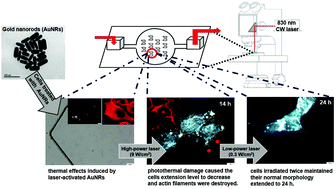The influence of laser intensity activated plasmonic gold nanoparticle-generated photothermal effects on cellular morphology and viability: a real-time, long-term tracking and monitoring system†
Abstract
In this study, a microfluidic apparatus embedded with microstructures was designed and aligned with a laser and dark-field microscope for real-time, long-term observation of photothermal effects on cells. Gold nanorods (AuNRs, 10 ppm) were incubated with MG-63 human osteosarcoma cells for 3 h. Then, the cells were exposed to a continuous-wave laser at a wavelength of 830 nm for 10, 20, and 30 min at 5, 9, 14, 24, and 32 W cm−2. Subsequent changes in morphology were observed. Under different conditions, cell membrane blebbing occurred at different times, indicating that actin filaments were destroyed in large quantities and apoptosis was induced. In suitable conditions, we first induced slight cell injury by causing cytoskeletal fractures with a high-energy laser; then, the cells were irradiated with a low-energy laser at 0.3 W cm−2. We found that among cells treated with the high-energy laser, cells treated additionally with a low-energy laser showed extended viability compared with cells that did not receive the additional treatment.



 Please wait while we load your content...
Please wait while we load your content...